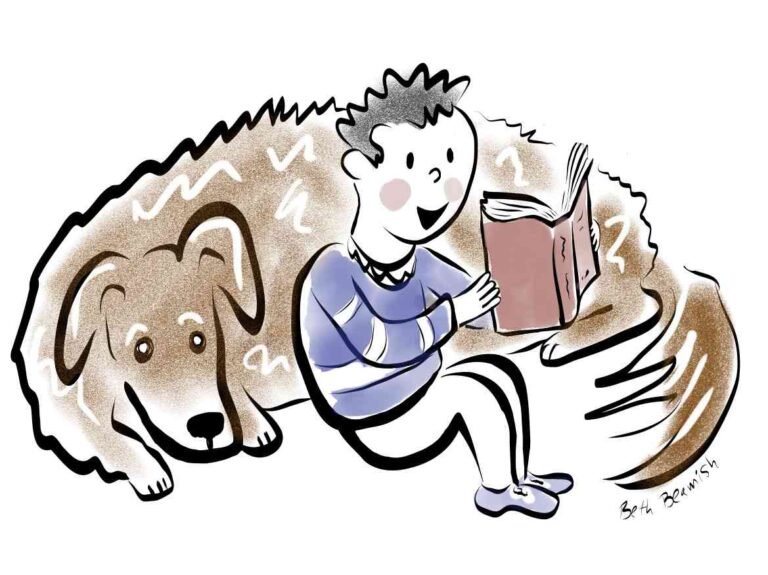
How Going Gluten-Free Transformed our Home
Hi, I’m Melissa, Beth asked me to explain how going gluten-free made a difference in our household. I have a

According to Marie Rippel at All About Learning Press:
“Fluency is the ability to read with accuracy, proper speed, and meaningful expression. Fluency is also a significant indicator of reading comprehension. When children can read fluently, it means that instead of using brain power for decoding, they can turn their attention to the meaning of the text.”
My son Harry struggled to learn to read and made all the usual mistakes. He stumbled over, substituted, and needed to sound out multiple words on every page.
Harry’s problem was he couldn’t decode words. Here is a post about how to tell if your child has a reading problem. I purchased Marie Rippel’s All About Reading programme (affiliate link) to help him. Harry developed his decoding skills using this material by reading single words on flashcards. Once he knew them, he read these words in simple sentences. After practising the activity sheets, he could read these words in stories whenever he came across them.
If you’ve ever tried reading a book on an unfamiliar topic, you may have stumbled over words you didn’t understand. When I was in primary school, I told my friend I liked eating muscly for breakfast. My friend was perplexed. What kinds of muscle did my wolf-like family tear into each morning?
I described the cereal.
“Oh, you mean muesli,” she said.
I blushed. That was the first time I’d heard the word spoken.
To develop fluency, ensure your child knows how to pronounce the words they encounter in the text. You can read my post on how to help build a child’s vocabulary here.
When a child hears fluent reading, it is easier for them to understand and mimic it.
If you have children under six, you may like to watch this short video by early years advisor Sarah Kingham. Sarah established the Readit2 literacy programme in 2006 to encourage adults to read to children. She stresses pointing out words as you read and explaining what they mean.
For older children, especially those with dyslexia, reading can feel like a chore. However, if you continue to read to them as they grow, you allow them to access texts they may struggle to read alone. My husband read the Harry Potter books and The Lord of the Rings to our son because these were the books his friends were reading.
When a child hears you read, they take in the tone, inflections, and correct reading speed. They also hear how you break sentences into phrases. To show your child how you phrase a sentence, pick one sentence on the page, and explain how you broke it into chunks when you read it. For example:
Ben knew perfectly well they’d be disappointed that the cage hadn’t squashed him.
A fluent reader naturally groups words:
Ben knew perfectly well… they’d be disappointed… that the cage hadn’t squashed him.
If you own the book you are reading, circle the words in each phrase with a pencil to show these chunks.
One way to encourage fluency is to model expressive reading. Read a page from their book a couple of times, demonstrating how to pay attention to punctuation and emphasize important words. Then ask the child to give it a go. Encourage what they get right and correct them a couple of times but keep the experience positive. If a whole page is too much for them, start with a short paragraph.
Although a child needs to be able to read silently, they must read aloud to improve fluency.
My library has a read-to-a-dog programme to help children develop fluent reading.
Their website says dogs:
If you don’t have a dog, perhaps your child could read to another pet; even a goldfish will work. If a pet isn’t available, ask a friendly neighbour or grandparent to listen to them read, but be sure to coach the adult on the need for encouragement rather than criticism.
Many phones have recording apps, and allowing a child to record their reading and play it back can be helpful. Encourage your child to notice one thing they did well and one thing they could do better. Then they can re-record the page to see if they can improve.
Developing reading fluency takes time and practice.
If you want to know about the All About Reading programme I used to help Harry become a fluent reader, check out this affiliate link.
Speechify is an app that can help dyslexic children as it reads online text. Here is my affiliate link.

Hi, I’m Beth. Seven years ago, when I discovered my son had dyslexia, I had a ‘light-bulb’ moment and understood this explained many of my own difficulties. Ever since, I’ve been on a mission to discover the best ways to wrestle what I like to call the dyslexia octopus.

Hi, I’m Melissa, Beth asked me to explain how going gluten-free made a difference in our household. I have a

I need nighttime anxiety relief. It’s 4 AM, and I’m reviewing what happened to Harry at school yesterday and wondering